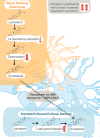Plasma sterols and depressive symptom severity in a population-based cohort
- PMID: 28886149
- PMCID: PMC5590924
- DOI: 10.1371/journal.pone.0184382
Plasma sterols and depressive symptom severity in a population-based cohort
Abstract
Convergent evidence strongly suggests major depressive disorder is heterogeneous in its etiology and clinical characteristics. Depression biomarkers hold potential for identifying etiological subtypes, improving diagnostic accuracy, predicting treatment response, and personalization of treatment. Human plasma contains numerous sterols that have not been systematically studied. Changes in cholesterol concentrations have been implicated in suicide and depression, suggesting plasma sterols may be depression biomarkers. Here, we investigated associations between plasma levels of 34 sterols (measured by mass spectrometry) and scores on the Quick Inventory of Depressive Symptomatology-Self Report (QIDS-SR16) scale in 3117 adult participants in the Dallas Heart Study, an ethnically diverse, population-based cohort. We built a random forest model using feature selection from a pool of 43 variables including demographics, general health indicators, and sterol concentrations. This model comprised 19 variables, 13 of which were sterol concentrations, and explained 15.5% of the variation in depressive symptoms. Desmosterol concentrations below the fifth percentile (1.9 ng/mL, OR 1.9, 95% CI 1.2-2.9) were significantly associated with depressive symptoms of at least moderate severity (QIDS-SR16 score ≥10.5). This is the first study reporting a novel association between plasma concentrations cholesterol precursors and depressive symptom severity.
Conflict of interest statement
Figures





References
-
- Moussavi S, Chatterji S, Verdes E, Tandon A, Patel V, Ustun B. Depression, chronic diseases, and decrements in health: results from the World Health Surveys. Lancet. 2007;370(9590):851–8. doi: 10.1016/S0140-6736(07)61415-9 . - DOI - PubMed
-
- Huang TL, Lin CC. Advances in biomarkers of major depressive disorder. Advances in clinical chemistry. 2015;68:177–204. doi: 10.1016/bs.acc.2014.11.003 . - DOI - PubMed
-
- Beasley CL, Honer WG, Bergmann K, Falkai P, Lutjohann D, Bayer TA. Reductions in cholesterol and synaptic markers in association cortex in mood disorders. Bipolar disorders. 2005;7(5):449–55. doi: 10.1111/j.1399-5618.2005.00239.x . - DOI - PubMed
-
- Boscarino JA, Erlich PM, Hoffman SN. Low serum cholesterol and external-cause mortality: potential implications for research and surveillance. Journal of psychiatric research. 2009;43(9):848–54. doi: 10.1016/j.jpsychires.2008.11.007 . - DOI - PubMed
MeSH terms
Substances
Grants and funding
LinkOut - more resources
Full Text Sources
Other Literature Sources
Medical

